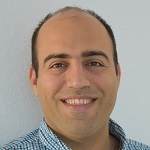Appearance Management for 3D Printing and Laser Marking
Hosted By: Color Technical Group
01 August 2022 11:00 - 12:00
Eastern Time (US & Canada) (UTC -05:00)Commercially available advanced manufacturing devices, such as 3D printers or laser marking systems, allow for creating multi-material 3D composites or laser-material processing at very high resolutions. There is huge potential for the reproduction of various objects (e.g., cultural heritage artifacts) or the creation of disruptive products never possible before. Appearance simulation, i.e., prediction of the output, fabricated appearance as a function of material arranged in a 3D multi-material grid, or laser parameters for a laser marking system, is arguably the main challenge in any appearance management workflow.
In this webinar hosted by the Color Technical Group, Vahid Babaei argues that data-driven approaches have an immense capacity for accurate and efficient appearance prediction. Unlike physical models that rely on the sophisticated relationship of highly specialized measurements, data-driven models count on the power of big but simple data to acquire. Babaei proposes a measurement-based data-driven performance space exploration of the color laser marking process. Babaei formulates this exploration as a search for the Pareto optimal solutions to multi-objective optimization and solves it using an evolutionary algorithm. The explored set of diverse colors is then utilized to mark high-quality, full-color images.
Subject Matter Level:
- Intermediate - Assumes basic knowledge of the topic
What You Will Learn:
- The novel trend of data-driven approaches for appearance reproduction
- The state of the novel hardware suitable for appearance reproduction
Who Should Attend:
- Scientists and engineers working in 3D printing at all career levels
- Professionals and practitioners in other fields interested in 3D printing
About the Presenter: Vahid Babaei, Max Planck Institute for Informatics
 Vahid Babaei leads the AI-aided Design and Fabrication Group at the Computer Graphics Department of the Max Planck Institute for Informatics. He spent two years as a postdoctoral researcher at the Computer Science and Artificial Intelligence Laboratory (CSAIL) of the Massachusetts Institute of Technology (MIT). He obtained his Ph.D. in Computer Science from Ecole Polytechnique Fédérale de Lausanne (EPFL). His research interest lies at the intersection of manufacturing and computer science. His research aims to develop computational algorithms necessary for advanced manufacturing tools, such as multi-material 3D printers, to create products with novel, interesting and useful appearance specifications.
Vahid Babaei leads the AI-aided Design and Fabrication Group at the Computer Graphics Department of the Max Planck Institute for Informatics. He spent two years as a postdoctoral researcher at the Computer Science and Artificial Intelligence Laboratory (CSAIL) of the Massachusetts Institute of Technology (MIT). He obtained his Ph.D. in Computer Science from Ecole Polytechnique Fédérale de Lausanne (EPFL). His research interest lies at the intersection of manufacturing and computer science. His research aims to develop computational algorithms necessary for advanced manufacturing tools, such as multi-material 3D printers, to create products with novel, interesting and useful appearance specifications.
